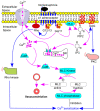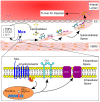Sympathetic Nervous System and Atherosclerosis
- PMID: 37685939
- PMCID: PMC10487841
- DOI: 10.3390/ijms241713132
Sympathetic Nervous System and Atherosclerosis
Abstract
Atherosclerosis is characterized by the narrowing of the arterial lumen due to subendothelial lipid accumulation, with hypercholesterolemia being a major risk factor. Despite the recent advances in effective lipid-lowering therapies, atherosclerosis remains the leading cause of mortality globally, highlighting the need for additional therapeutic strategies. Accumulating evidence suggests that the sympathetic nervous system plays an important role in atherosclerosis. In this article, we reviewed the sympathetic innervation in the vasculature, norepinephrine synthesis and metabolism, sympathetic activity measurement, and common signaling pathways of sympathetic activation. The focus of this paper was to review the effectiveness of pharmacological antagonists or agonists of adrenoceptors (α1, α2, β1, β2, and β3) and renal denervation on atherosclerosis. All five types of adrenoceptors are present in arterial blood vessels. α1 blockers inhibit atherosclerosis but increase the risk of heart failure while α2 agonism may protect against atherosclerosis and newer generations of β blockers and β3 agonists are promising therapies against atherosclerosis; however, new randomized controlled trials are warranted to investigate the effectiveness of these therapies in atherosclerosis inhibition and cardiovascular risk reduction in the future. The role of renal denervation in atherosclerosis inhibition in humans is yet to be established.
Keywords: alpha blocker; atherosclerosis; beta blocker; blood vessel; renal denervation; sympathetic activity.
Conflict of interest statement
The authors declare no conflict of interest.
Figures






References
-
- Shen Y., Ward N.C., Hodgson J.M., Puddey I.B., Wang Y., Zhang D., Maghzal G.J., Stocker R., Croft K.D. Dietary quercetin attenuates oxidant-induced endothelial dysfunction and atherosclerosis in apolipoprotein E knockout mice fed a high-fat diet: A critical role for heme oxygenase-1. Free Radic. Biol. Med. 2013;65:908–915. doi: 10.1016/j.freeradbiomed.2013.08.185. - DOI - PubMed
-
- Watts G.F., Gidding S.S., Hegele R.A., Raal F.J., Sturm A.C., Jones L.K., Sarkies M.N., Al-Rasadi K., Blom D.J., Daccord M., et al. International Atherosclerosis Society guidance for implementing best practice in the care of familial hypercholesterolaemia. Nat. Rev. Cardiol. 2023 doi: 10.1038/s41569-023-00892-0. ahead of print . - DOI - PubMed
Publication types
MeSH terms
Substances
Grants and funding
LinkOut - more resources
Full Text Sources
Medical

